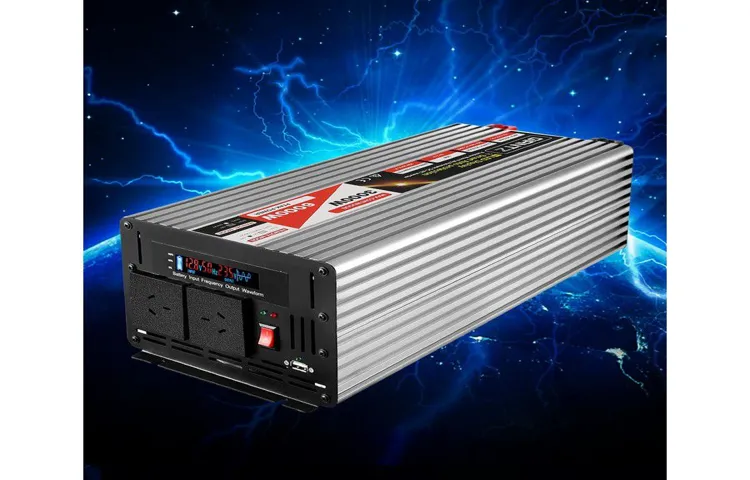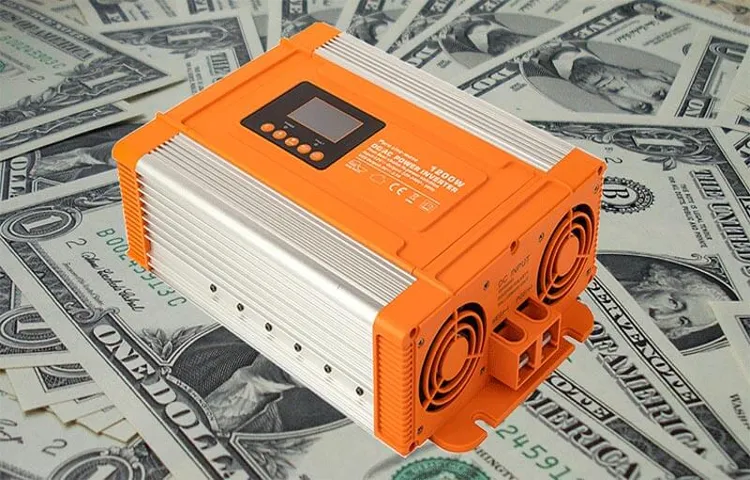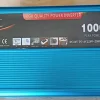Have you ever wondered how inverters work and how they affect power consumption? Inverters play a crucial role in our daily lives, especially when it comes to powering our electronic devices. They are commonly used in solar power systems, cars, and even in backup power supplies. Understanding how inverters function and their impact on power consumption can help you make informed decisions about energy usage and ultimately save on your electricity bills.
Inverters are electronic devices that convert direct current (DC) into alternating current (AC). They are essential in situations where AC power is required but only DC power is available. For example, when you plug your phone charger into a wall outlet, the AC power from the grid is converted into DC power to charge your phone’s battery.
Inverters work in reverse by converting DC power into AC power, allowing you to use your electronic devices wherever you are. When it comes to power consumption, inverters can have both positive and negative effects. On one hand, they allow us to access AC power from sources that only provide DC power, expanding our options for energy usage.
On the other hand, inverters themselves consume some electricity in the conversion process. The efficiency of an inverter determines how much power is lost during the conversion. Higher efficiency means less power loss, resulting in reduced energy consumption and ultimately lower electricity bills.
To better understand this concept, let’s think of inverters as a translator. Imagine you have a book written in one language (DC power) and you want to read it in another language (AC power). The translator (inverter) takes the text and converts it into the language you can understand.
However, just like a translator may not convey every nuance or detail accurately, the inverter also loses some energy in the conversion process. In summary, inverters are essential devices that allow us to use AC power from sources that only provide DC power. While they consume some electricity themselves, their efficiency plays a crucial role in minimizing power consumption.
Table of Contents
What is an Inverter?
When it comes to inverters, understanding how much power they use is important. A 2500w inverter refers to an inverter that can provide up to 2500 watts of power. However, the amount of power it consumes from your power source will depend on various factors.
Inverters generally have an efficiency rating, which indicates how effectively they can convert the direct current (DC) power from your battery into alternating current (AC) power. On average, inverters have an efficiency rating of around 80-90%, meaning that they consume 10-20% more power than what they actually deliver. This means that a 2500w inverter may consume around 2750-3000 watts of power from your battery.
However, it’s important to note that the power consumed by an inverter can vary depending on its load, meaning the amount of power being drawn by the devices connected to it. So, if you have devices connected to your inverter that have a total power consumption of 2000 watts, the inverter will only consume the power it needs to provide that much load, rather than using its full capacity.
Definition and Function
inverter, definition and function, What is an Inverter? An inverter is a device that converts direct current (DC) electricity into alternating current (AC) electricity. It is an essential component in solar power systems and backup power systems. When sunlight hits solar panels, it generates DC electricity.
However, most household appliances and electronics run on AC electricity. This is where the inverter comes in. It takes the DC electricity produced by the solar panels or stored in batteries and converts it into AC electricity that can be used to power a variety of devices and appliances.
Inverters play a crucial role in ensuring that renewable energy sources like solar power are compatible with our existing electrical grid. Without inverters, the electricity generated by solar panels or stored in batteries would not be usable in our homes and businesses. Inverters are also equipped with various features to ensure the safety and efficiency of the electricity being converted, such as surge protection, voltage regulation, and grid-tie capabilities.
In summary, inverters are the bridge between DC electricity generated by renewable energy sources and the AC electricity needed to power our homes and appliances. They are essential for harnessing and utilizing clean and renewable energy efficiently.

Types of Inverters
solar inverters, types of inverters, inverter technology, grid-tied inverters, off-grid inverters, hybrid inverters, microinverters, string inverters, central inverters
Power Consumption of a 2500W Inverter
If you’re wondering about how much power a 2500W inverter uses, it’s important to understand its power consumption. A 2500W inverter is designed to convert DC power from a battery into AC power for use in various electrical devices. The power consumption of the inverter itself will depend on several factors, such as the efficiency of the inverter and the load connected to it.
In general, inverters are not 100% efficient, which means they will consume some power while they are in operation. The actual power consumption will vary depending on the specific model and usage scenarios. It’s always a good idea to check the specifications provided by the manufacturer to get a clearer idea of the power consumption of your particular inverter.
Calculating Power Consumption
power consumption, 2500W inverter
Factors Affecting Power Consumption
power consumption, inverter, factors, 2500W When it comes to power consumption, there are several factors that can affect it. One of the main factors is the type and capacity of the inverter being used. Inverters are electronic devices that convert DC power into AC power, allowing you to use your appliances and devices that require AC power.
A 2500W inverter, for example, has a capacity of 2500 watts, which means it can handle the power requirements of devices that consume up to 2500 watts of power. Another factor that can affect power consumption is the efficiency of the inverter. Inverters are not 100% efficient, which means that some of the power that is input into the inverter is lost as heat.
The efficiency of an inverter is typically expressed as a percentage, with higher percentages indicating higher efficiency. A more efficient inverter will waste less power as heat and therefore consume less power overall. The load that is connected to the inverter is also an important factor in power consumption.
The load refers to the devices and appliances that are connected to the inverter and are using its power. Different devices have different power requirements, and using devices with higher power requirements will result in higher power consumption. Therefore, it’s important to consider the power requirements of the devices you plan to use with your inverter.
Lastly, the duration for which the inverter is used also affects power consumption. The longer the inverter is powered on, the more power it will consume. It’s important to consider how long you will be using the inverter and calculate the expected power consumption accordingly.
In conclusion, the power consumption of a 2500W inverter can be influenced by several factors. The type and capacity of the inverter, its efficiency, the load connected to it, and the duration for which it is used all play a role in determining how much power the inverter will consume. By considering these factors and making informed choices, you can optimize the power consumption of your inverter.
Efficiency of a 2500W Inverter
Have you ever wondered how much power a 2500W inverter actually uses? Well, let me break it down for you. An inverter is a device that converts DC power (from a battery or solar panel) into AC power (the type of power we use in our homes). When it comes to efficiency, inverters vary in how well they convert power.
Generally, a good quality inverter will have an efficiency rating of around 90%. This means that for every 100W of DC power supplied to the inverter, it will output 90W of AC power. So, if you have a 2500W inverter, it will require around 2778W of DC power to operate at full capacity.
Keep in mind that efficiency can vary depending on the load and quality of the inverter, so it’s always a good idea to check the specifications of the specific model you are using. With that being said, it’s worth investing in a high-quality inverter to ensure that you are getting the most out of your power source.
Understanding Efficiency
efficiency, 2500W inverter Did you know that the efficiency of a 2500W inverter plays a significant role in how effectively it converts DC power to AC power? Efficiency refers to the ability of the inverter to convert the available power from the input source to the desired output power without any significant losses. In other words, it determines how much of the input power is actually converted into usable output power. A higher efficiency rating means that the inverter can convert a larger percentage of the input power, resulting in less wasted energy.
This is important because wasted energy not only leads to higher utility bills but also contributes to environmental pollution. So, when choosing a 2500W inverter, it’s essential to consider its efficiency rating to ensure you get the most out of your power source.
Factors Affecting Inverter Efficiency
Inverter efficiency is an important factor to consider when choosing a 2500W inverter. Efficiency refers to how well an inverter can convert DC power from a battery into AC power for everyday use. A higher efficiency means less power is wasted during the conversion process, resulting in more power being available for your devices.
There are several factors that can affect the efficiency of an inverter. First, the quality of the inverter itself plays a role. Higher quality inverters are designed with better components and are more likely to have higher efficiency ratings.
Additionally, the operating temperature of the inverter can impact its efficiency. Inverters that operate at higher temperatures may have reduced efficiency due to increased resistance and heat losses. Another factor to consider is the load on the inverter.
Inverters operate most efficiently when they are operating at a moderate load, so it’s important to consider how much power you will be drawing from the inverter on a regular basis. Finally, the quality of the DC power source, such as the battery, can also affect inverter efficiency. A battery with low voltage or high internal resistance may not provide the optimal conditions for the inverter to operate efficiently.
Overall, when choosing a 2500W inverter, it’s important to consider all these factors to ensure you get the most efficient and reliable performance.
Tips for Reducing Power Consumption
When it comes to power consumption, it’s helpful to understand how much power a 2500w inverter uses. An inverter is a device that converts direct current (DC) power from a battery into alternating current (AC) power that can be used to power various appliances and devices. The power usage of a 2500w inverter primarily depends on the load it is running.
If the inverter is running at its full capacity of 2500 watts, it will consume the full power output. However, if the load being powered by the inverter is less than 2500 watts, the inverter will only consume as much power as the load requires. It’s important to note that the efficiency of the inverter also plays a role in power consumption.
Higher efficiency inverters will convert more of the battery power into usable AC power, resulting in less power loss and lower overall power consumption. Therefore, it’s always a good idea to invest in a high-quality, efficient inverter to minimize power usage. Additionally, being mindful of the appliances and devices being powered by the inverter can help reduce power consumption.
Opting for energy-efficient appliances and turning off unnecessary devices can make a significant difference in power usage.
Choosing the Right Inverter
“Choosing the Right Inverter: Tips for Reducing Power Consumption” Are you tired of high electricity bills? Well, one way to reduce your power consumption and save some bucks is by choosing the right inverter. An inverter is an essential device that converts DC power to AC power, allowing you to run your household appliances. But with so many options available in the market, how do you choose the right one? Firstly, consider the power rating of the inverter.
This is determined by the wattage of the appliances you want to run. Make sure the inverter you choose can handle the total power requirement of your appliances. Next, look for an inverter with good energy efficiency.
The efficiency of an inverter is measured by how much power it can convert without wasting energy. One way to determine this is by checking the inverter’s efficiency rating. A higher rating means less energy wastage and more savings for you.
Another important factor to consider is the input voltage range of the inverter. This refers to the range of voltage that the inverter can accept from your batteries. Ensure that the inverter you choose can handle the voltage output of your batteries, or else it might not work efficiently.
Additionally, look for an inverter with safety features such as overload protection and surge protection. These features can protect your appliances and the inverter itself from electrical damage. Lastly, don’t forget to take into account your budget.
Inverters come in various price ranges, so choose one that fits your budget without compromising on quality. By following these tips, you can choose the right inverter and reduce your power consumption, leading to lower electricity bills. So, why wait? Start saving money now!
Using Energy-Efficient Appliances
energy-efficient appliances, power consumption. Are you looking to reduce your power consumption and save on your energy bills? One way to achieve this is by using energy-efficient appliances in your home. By upgrading to appliances that are designed to use less electricity, you can effectively lower your overall power consumption.
Energy-efficient appliances are specifically designed to minimize energy usage and wastage, making them a more sustainable and cost-effective option. From refrigerators and dishwashers to washing machines and air conditioners, there are a variety of energy-efficient appliances available on the market today. These appliances are designed to perform the same tasks as their standard counterparts, but with the added benefit of using less power.
By switching to energy-efficient appliances, you not only reduce your carbon footprint, but you also save money on your energy bills in the long run. So why not make the switch and start enjoying the benefits of energy-efficient appliances today?
Optimizing Battery Usage
battery usage, power consumption, reducing power consumption, optimizing battery usage, tips for reducing power consumption. Are you tired of your smartphone’s battery constantly running low? If so, you’re not alone. Many people struggle with optimizing battery usage and reducing power consumption on their devices.
Fortunately, there are some simple tips you can try to help extend your battery life. One of the easiest ways to reduce power consumption is to adjust your screen brightness. Lowering the brightness level can significantly decrease the amount of power your device uses.
Another tip is to turn off unnecessary notifications. Those constant alerts can drain your battery quickly. Additionally, closing unused apps and disabling background app refresh can also help conserve battery life.
It may take some time to get used to these changes, but the benefits of longer battery life are worth it. So why not give these tips a try and see how much longer your battery lasts?
Maintaining Proper Inverter Settings
inverter settings, power consumption, reducing power consumption, maintaining proper inverter settings Do you know that by making a few simple adjustments to your inverter settings, you can significantly reduce your power consumption? That’s right! Your inverter plays a crucial role in converting the direct current (DC) produced by your solar panels into the alternating current (AC) that powers your appliances. By maintaining proper inverter settings, you can ensure that your system is running efficiently and effectively. So, how can you go about reducing power consumption through your inverter? Well, here are some helpful tips to get you started.
First and foremost, it’s important to make sure that your inverter is properly sized for your solar panel system. An oversized inverter can result in higher power losses and increased energy wastage. On the other hand, an undersized inverter may not be able to handle the load demand, leading to system inefficiencies.
Therefore, it’s essential to consult with a professional to determine the right inverter size for your specific needs. Additionally, you should regularly monitor and adjust the settings on your inverter. Many inverters come with built-in optimization features that allow you to fine-tune the performance of your system.
By monitoring the voltage, frequency, and other parameters, you can ensure that your inverter is operating at its optimum level. Furthermore, consider adjusting the power factor of your inverter. The power factor is a measure of how effectively electrical power is being used in your system.
By improving the power factor through inverter settings or adding power factor correction devices, you can reduce energy wastage and lower your electricity bills. Lastly, don’t forget to keep your inverter clean and well-maintained. Dust, debris, and other contaminants can inhibit the proper functioning of your inverter, leading to reduced efficiency and increased power consumption.
Regularly inspect and clean your inverter to ensure that it’s free from any obstructions. By following these tips and maintaining proper inverter settings, you can maximize the performance of your solar panel system and enjoy significant energy savings. So why wait? Start reducing your power consumption today!
Conclusion
So, to answer the burning question of how much power does a 2500W inverter actually use, we must embark on a journey of electrical enlightenment. Picture this: you’re in a world where electrons are the currency, and power is the almighty king. The 2500W inverter, a mystical sorcerer of electricity, is here to grant your wishes, but demands its own tribute of power in return.
But fear not, dear seeker of knowledge, for I shall unravel the secrets of this powerful genie. The 2500W inverter, in all its glory, has the potential to consume a substantial amount of power. However, its actual usage depends on the devices connected to it, like a grand feast prepared for the inverter’s delight.
Think of it this way: the inverter is like the conductor of an electric orchestra, controlling the flow of electrons and harmonizing their dance. When you connect a device to the inverter, it’s like inviting a musician to join the performance. Each musician, or device, requires a certain amount of power to play their instrument.
So, the total power consumed by the inverter depends on the combined appetite of its musical companions. If you connect a power-hungry device like a massive speaker system, the inverter will work hard to provide the necessary power, consuming a larger portion of its own energy. Conversely, if you connect a small, energy-efficient device, the inverter will happily oblige by sipping a modest amount of power.
Think of it as a symbiotic relationship between power and consumption, a dance of electrons and devices, bonded by the inverter’s enchanting presence. And in this grand musical spectacle, the 2500W inverter’s power usage is merely a fluid concept, ever-changing and adapting to the needs and whims of its connected devices. So, dear reader, I hope this whimsical explanation has shed some light on the mysterious realm of power consumption in the land of inverters.
Remember, the power of knowledge is just as mighty as the power of electricity itself. And armed with this knowledge, you are now ready to embark on your own electrifying adventures in this mystical realm.
FAQs
How does a 2500w inverter work?
A 2500w inverter works by converting DC (direct current) power from a battery into AC (alternating current) power that can be used to power household appliances or other devices. It uses electronic components to convert the voltage and frequency of the power.
Can a 2500w inverter handle appliances with high power requirements?
Yes, a 2500w inverter can handle appliances with high power requirements, as long as their total power consumption does not exceed 2500 watts. It’s important to check the power requirements of each appliance before connecting them to the inverter.
How much power does a 2500w inverter consume when idle?
When idle, a 2500w inverter consumes a small amount of power to maintain its electronics and standby functionality. This power consumption is typically minimal, usually less than 1-5 watts, depending on the specific model and brand.
What are the safety features of a 2500w inverter?
A 2500w inverter usually comes with various safety features, such as overload protection, over-temperature protection, short-circuit protection, and low-voltage alarm or shutdown. These features help protect the inverter and the connected appliances from damage or electrical hazards.
Can a 2500w inverter be used with solar panels?
Yes, a 2500w inverter can be used with solar panels to convert the DC power generated by the solar panels into usable AC power. It can be used in off-grid solar systems or as part of a grid-tied solar system with battery backup.
What type of battery is recommended for use with a 2500w inverter?
A 2500w inverter can be used with various types of batteries, such as deep cycle batteries, AGM (absorbent glass mat) batteries, or lithium-ion batteries. The choice of battery depends on factors like the expected power usage, required battery capacity, and budget.
Can a 2500w inverter be used in a vehicle?
Yes, a 2500w inverter can be used in a vehicle to power appliances or charge devices while on the go. It can be connected to the vehicle’s battery and used to run small appliances like laptops, mini-fridges, or power tools. However, it’s important to ensure that the vehicle’s battery can handle the power requirements of the inverter.
How long can a 2500w inverter power appliances before the battery drains? A8. The duration of power supply provided by a 2500w inverter depends on the capacity of the battery it is connected to. The larger the battery’s capacity, the longer it can power appliances. It’s also influenced by the power consumption of the connected appliances. To calculate the estimated running time, divide the battery capacity (in watt-hours or amp-hours) by the total power consumption of the appliances.



